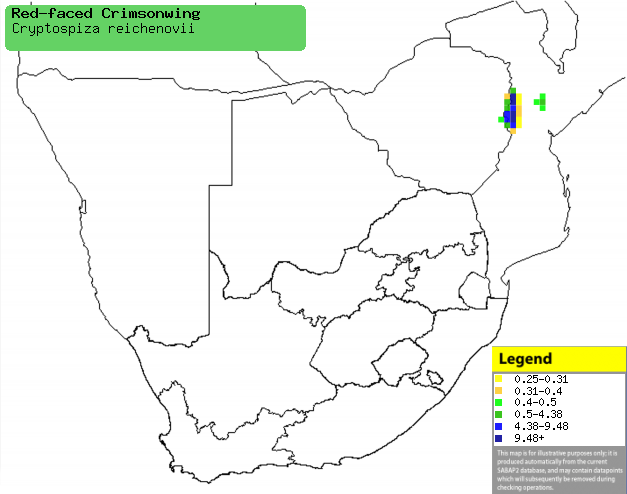|
Cryptospiza reichenovii
(Red-faced crimsonwing)
Rooiwangwoudsysie [Afrikaans]; Reichenows bergastrild
[Dutch]; Sénégali de Reichenow [French]; Reichenows bergastrild
[German]; Asa-vermelha-de-mascarilha [Portuguese]
Life
> Eukaryotes >
Opisthokonta
> Metazoa (animals) >
Bilateria >
Deuterostomia > Chordata >
Craniata > Vertebrata (vertebrates) > Gnathostomata (jawed
vertebrates) > Teleostomi (teleost fish) > Osteichthyes (bony fish) > Class:
Sarcopterygii (lobe-finned
fish) > Stegocephalia (terrestrial
vertebrates) > Tetrapoda
(four-legged vertebrates) > Reptiliomorpha > Amniota >
Reptilia (reptiles) >
Romeriida > Diapsida > Archosauromorpha > Archosauria >
Dinosauria
(dinosaurs) > Saurischia > Theropoda (bipedal predatory dinosaurs) >
Coelurosauria > Maniraptora >Aves
(birds) > Order: Passeriformes
> Family: Estrildidae
 |
|
|
Red-faced crimsonwing, Bvumba Mountains, Zimbabwe.
[K Vang, W Dabrowka/ Bird
Explorers / AFBID
©] |
|
Distribution and habitat
It has isolated populations scattered across sub-Saharan
Africa, in West Africa, western Angola and the area from Tanzania to northern
Malawi and eastern Zambia, with a localised population in Zimbabwe's eastern
highlands and adjacent Mozambique, including the area around Mount Gorongosa. It
generally prefers clearings and edges of evergreen montane forest, bracken-brier
and other dense vegetation along rivers and sometimes in the forest interior,
also occurring in well-wooded gardens and tea and pine plantations.
|
 |
|
Distribution of Red-faced crimsonwing in southern Africa,
based on statistical smoothing of the records from first SA Bird Atlas
Project (©
Animal Demography unit, University of
Cape Town; smoothing by Birgit Erni and Francesca Little). Colours range
from dark blue (most common) through to yellow (least common). |
Food
It mainly eats grass seeds supplemented with insects, doing
most of its foraging on the ground or in undergrowth. The following food items
have been recorded in its diet:
- Seeds
- grass
- Panicum (guinea grasses)
- Setaria (millets and bristle grasses)
- Streblochaete longiarista (forest grass)
- maize
- Pinus patula (Cluster pine)
- Insects
Breeding
- The nest is mainly built by the female with material gathered by the male,
consisting of an oval ball of fine grass, moss and skeletonised leaves, with
a spout-like entrance protruding from the side. The interior is lined with
feathery grass seedheads, plant down, feathers and sometimes Marasmius
fungus. It is typically placed in the fork of a tree fern, sapling, or
thorny bush.
- Egg-laying season is from September-March.
- It lays 3-5 eggs, which are incubated by both sexes (recorded in
captivity).
- The chicks are fed and brooded by both parents, leaving the nest after
about 21 days and becoming fully independent about 10-12 days later.
Threats
Not threatened, although it is vulnerable to destruction of
montane habitats.
References
-
Hockey PAR, Dean WRJ and Ryan PG 2005. Roberts - Birds of
southern Africa, VIIth ed. The Trustees of the John Voelcker Bird Book
Fund, Cape Town.
x |
